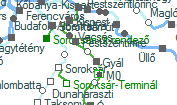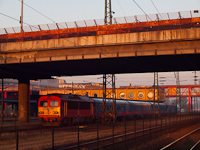The MÁV-START 418 157 seen between Gyál and Gyál felső
Budapest - Lajosmizse - Kecskemét | |||||
| Megnyitás: |
| ||||
|---|---|---|---|---|---|
| Hossz: | ~122 km | ||||
| Építtető: | Budapest-Tiszai HÉV | ||||
| Villamosítás: | - | ||||
| Személyszállító vasút: | MÁV-START Zrt. | ||||
A vasútvonal egyes szakaszainak kiépítésére különböző HÉV-ek alakultak, ám a tényleges beruházást már az egyesülésükkel létrejött Budapest-Tiszai HÉV végezte. A vonalak teljes egészükben Pest-Pilis-Solt-Kiskun vármegyében vezettek, mivel Tiszaugnál a Tisza-híd nem épült meg, csak egy folyami rakodó lett a lakiteleki oldalon a vonal végpontja. A Második Világháború után Lakitelek és Kunszentmárton között új nyomvonalon épült meg a vonal folytatása, amely magában foglalta a tiszaugi közös közúti-vasúti hidat is. A vonalnak elsősorban stratégiai jelentősége volt, személy- vagy teherforgalma nem volt jelentős, ma minimális számú személyszállító vonat közlekedik rajta. A menetrendekben és az Atlaszban 145-ös számmal található meg. Kecskemét alsó pályaudvar és Kecskemét között a Kecskemét - Fülöpszállási HÉV vonalát használta péage-forgalomban. A Kecskemét felől bejárható Hetényegyháza - Kerekegyháza szakasz 1974. december 31-én szűnt meg. | |||||
| |||||
Though my Line Card feature is not (yet) available in English, the opening dates of the various sections of the railroad in question may be important. The Budapest-Tiszai HÉV (Local Railway) was created by the fusion of a number of smaller companies and developed small branch lines in the Kunság region of the Great Plain of Hungary. The line from Kecskemét, a current county capital, to Tiszaug, only led to the side of the Tisza river opposite Tiszaug village, where a wharf was erected. The railway only crossed the river after World War 2, when the rebuilt road bridge was strengthened to carry the railway as well. The line never had much economical impact and currently operates with no freight and minimal passenger traffic - it was considered a strategic development by the Soviet Union.
The rest of the network is in the commuter area of Budapest and Kecskemét, still the infrastructure, allowed speeds and stations don't reflect the potential the railway has. As it always had its mainline alternatives it was never really overdeveloped and even though the current Hungarian Orbán-government calls itself a railway friendly government, it is only true as far as loads of concrete structures can be built by one of the companies of the childhood friend of the prime minister.
The biggest problem with this railway is that here a lot of real work would have to be done instead of just re-laying the tracks where they had been, so here the profit margin is a lot less, and also, the development would have to be done from Hungarian money, not EU-funds as it is in the most developed region and there is no international benefit, which the governement doesn't really like; domestic funds can be directly stolen (for example just given to Matthias Corvinus Collegium, a private sunday school system that is closely tied to conservative ideology and politics, who recieved EUR millions in cash and stock without any kind of reason or required contribution), no need for some construction work to accompany it.
The speed limit is 40 to 60 kph, the modern-looking Desiro railcars are too old and too unreliable to serve the line, even though their relocation here was the most the government wanted to do for the line. The only improvement happening here in the recent past is Gyál station receiving a Prolan-designed electronic small station interlocking as a test with motorised switches and light signals instead of the semaphoeres with no connection to the status of the points; and the development of Inárcs-Kakucs station to be able to manage train passings which was necessary for the introduction of a periodic timetable.
Photo by Takács Bence
Copyright 2005-2024. www.benbe.hu. Railway photography gallery of Takács Bence.




